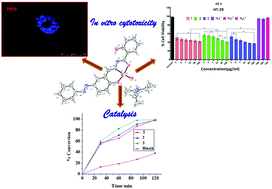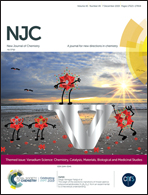In vitro cytotoxicity and catalytic evaluation of dioxidovanadium(v) complexes in an azohydrazone ligand environment†
Abstract
Three new anionic dioxidovanadium(V) complexes (HNEt3)[VO2(L)1–3] (1–3) of tridentate binegative aroylhydrazone ligands containing the azobenzene moiety were synthesized and structurally characterized. The aroylhydrazone ligands (H2L1–3) were derived from the condensation of 5-(arylazo) salicylaldehyde derivatives with the corresponding aroyl hydrazides. All the synthesized ligands and metal complexes were successfully characterized by several physicochemical techniques, namely, elemental analysis, electrospray ionization mass spectrometry, spectroscopic methods (IR, UV-vis and NMR), and cyclic voltammetry. Single-crystal X-ray diffraction crystallography of 1–3 revealed five-coordinate geometry, where the ligand coordinates to the metal centre in a binegative tridentate O, N, O coordinating anion and two oxido-O atoms, resulting in distortion towards the square pyramidal structure. The complexes were further evaluated for their in vitro cytotoxicity against HeLa and HT-29 cancer cell lines. All the complexes manifested a cytotoxic potential that was found to be comparable with that of clinically referred drugs, while complex 3 proved to be the most cytotoxic among the three complexes for both cell lines, which may be due to the synergistic effect of the naphthyl substituent in the azohydrazone ligand environment coordinated to the vanadium metal. The synthesized complexes 1–3 were probed as catalysts for the oxidative bromination of thymol and styrene as a functional mimic of vanadium haloperoxidases (VHPOs). All the reactions provided high percentages of conversion (>90%) with a high turnover frequency (TOF) in the presence of the catalysts 1–3. In particular, for the oxidative bromination of thymol, the percentage of conversion and TOF were in the ranges of 98–99% and 5380–7173 (h−1), respectively. Besides, 3 bearing the naphthyl substituent showed the highest TOF among all the complexes for the oxidative bromination of both thymol and styrene.

- This article is part of the themed collection: Vanadium Science: Chemistry, Catalysis, Materials, Biological and Medicinal Studies


 Please wait while we load your content...
Please wait while we load your content...